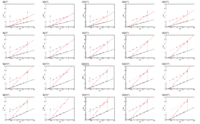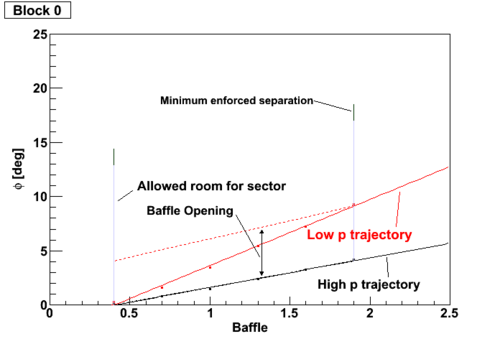Baffle Design
This page has been moved to https://solid.jlab.org/wiki/index.php/Baffle_Design in the new SoLID Wiki. Please do not edit this page.
Contents
Baffles Design
Designing baffles from ray traces requires GEMC runs without baffles, but detectors at the baffle z positions.
We define as fixed number of blocks which expand over a radius that will accept the full angular range from the whole target. Each block then has a range in phi, which we fit shown in the figture.
These are then considered, for each block over all baffles, to carve out an opening which does not allow particles below a momentum from making it through. There is a maximum opening which is defined from the number of sectors, along with a minimum "dead zone" which prevents photons.
First order efficiency curves
The efficiency can be estimated by considering the simple geometric arguments above, the two defining low and high momenta <math>p_{l}</math> and <math>p_{h}</math>, a maximum efficiency based on opening width (based on <math>p_{h}</math>) and number of sectors <math>n_{s}</math>, and a constant proportional to the field integral, <math>c_{Bdl}</math>.
The overall maximum efficiency is
<math>\epsilon_{max} = \frac{c_{Bdl} n_s}{2\pi p_{h}}</math>
Using one intermediate momentum <math>p_m</math> defined by
<math> p_m = \left( 1/p_{l} - 1/p_{h} \right)^{-1}</math>
there is an efficiency curve described by the piecewise function
| <math> p < p_l </math>: | <math>\epsilon = 0</math> |
| <math> p_l <p < p_m </math>: | <math> \epsilon_{max} \left(1+\frac{p_h}{p_m} - \frac{p_h}{p}\right) </math> |
| <math> p_m < p < p_h </math>: | <math> \epsilon_{max}</math> |
| <math> p_h < p </math>: | <math> \epsilon_{max}\frac{p_h}{p}</math> |
It is important to note the <math>\epsilon_{max}</math> is proportional to the field integral.
Baffle Design Results
Results for various fields, optimized with <math>p_h</math> of <math>x_{bj} = 0.55</math>.
The relative scale in efficiencies follows the relative field integrals:
Figure of Merit for baffle designs
Baffle code and file
code
https://jlabsvn.jlab.org/svnroot/solid/solid_gemc/analysistool/baffle
see the "readme" file, then the note below
- makebaf5.C_seamus is Seamus's original script which produce the "baffle_largerZ"
- makebaf5.C_zwzhao is based on makebaf5.C_seamus, but with a few modifications listed below by Zhiwen to produce the "baffle_smallerZ_cutinner".
- 1. the Z position for detector planes in "solout_CLEO_LD2_120d_nobaf_11GeV.root" was assumed to be 40,70,100,130,160,190cm, while they are actually 37.5,65.5,95.5,125.5,155.5,185.5cm
- 2. The designed baffle Z is changed from 40,70,100,130,160,190cm to 40,68,96,124,152,180cm. The new Z position is to avoid overlap and leave room for GEM. There are 10cm reduction for the total baffle length in Z.
- 3. The 1st baffle plane inner radius is fixed at 4cm. For other planes, their radius are determined by 21-36 degree polar angle acceptance from the full 40cm long target at Z=10cm.
file
http://hallaweb.jlab.org/12GeV/SoLID/download/baffle/
- baffle_largerZ_plot: files of "baffle_largerZ", produced by makebaf5.C_seamus, baffle geometry is defined in solid_CLEO_PVDIS_baffle_inspection.pl
- baffle_largerZ_extrablock_plot: files of "baffle_largerZ_extrablock", produced by makebaf5.C_seamus with SCALE_LASTBAF = 0.20, baffle geometry is defined in solid_CLEO_PVDIS_baffle_inspection_seamus.pl
- baffle_smallerZ_plot: files of "baffle_smallerZ", produced by makebaf5.C_zwzhao without limiting the 1st baffle plane inner radius at 4cm (which reaches about 2cm actually and create a lot radation), baffle geometry is defined in solid_CLEO_PVDIS_baffle.pl
- baffle_smallerZ_cutinner_plot: files of "baffle_smallerZ_cutinner", produced by makebaf5.C_zwzhao, baffle geometry is defined in solid_CLEO_PVDIS_baffle_inspection.pl
For now (6/18/2013), consider "baffle_smallerZ_cutinner" as the latest baffle. The "solid_CLEO_PVDIS_baffle.pl" in SVN is actually the old BaBar baffle by Eugene. We shall update it once we finalize the baffle.
The background files with various baffles are here http://hallaweb.jlab.org/12GeV/SoLID/download/sim/background/PVDIS_LD2/ refer to Solid_Background#background
babarmore1 Baffles
- Baffle parameterization [1], Rich
- pptxpdfweight xlsx Zhiwen and Rakitha
CLEO2 Baffles
- PVDIS baffle studies [2]
- weight xlsx Seamus
Older Baffle Designs and Comparisons
Seamus' Baffle Comparisons
| Eugene's BaBar Design in GEMC | [3] |
| Eugene's for Other Magnets | [4] |
| Basic New Designs | [5] |
| New design from ray tracing | [6] |
Eugene's Baffles
Zhiwen's Evaluation of Eugene's Baffles in GEMC
Note: These are based on an incorrect implementation






